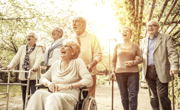
A witness watched in horror as security guards carried an elderly man with a walking frame out of an Adelaide hospital and left him on the footpath.
The disturbing scene at The Queen Elizabeth Hospital has sparked important questions about how we treat our most vulnerable patients when they need care the most.
The incident, captured by a shocked onlooker in the early hours of a Sunday morning, shows what can go wrong when hospital protocols fail to protect those who need protection most. But it also shines a light on a much larger problem facing Australia's healthcare system.
What happened at TQEH
The witness described seeing an elderly man asking for help: his speech was slurred, and you couldn't really understand him. Most tellingly, he couldn't walk without his walker—that was very obvious.
Yet despite his clear physical limitations and distressed state, security personnel physically removed him from the emergency department and left him outside with his frame near Woodville Road. “They didn't sit him up on his walker or anything like that,” the witness reported. “It was pretty disgusting to see from a healthcare service.”
According to the hospital, the man had been invited into the ED after appearing distressed in the ambulance bay, but was then asked to leave when his behaviour became “anti-social.” SA Health said the man was “safely” removed by security, and the Health Minister, Chris Picton, stressed that security staff are expected to use “the minimal amount of force that is required to make sure that people are safe.” The man—believed to be homeless—later returned to the ED but was not admitted as a patient.
The witness’s response cuts to the heart of the matter: “If that had happened to one of my family members, I could promise you I wouldn't be staying quiet about it.”
'If that had happened to one of my family members, I could promise you I wouldn't be staying quiet about it'
A bigger picture problem
This incident isn't happening in isolation. On ABS Census night in 2021, more than 122,000 people were estimated to be experiencing homelessness in Australia, up 5.2 per cent since 2016. Of those experiencing homelessness, 56 per cent were male, 58 per cent were younger than 35 and 20 per cent identified as First Nations.
For many, the ED is the first—and sometimes only—place to seek medical assistance. While primary care is a better, more cost-effective option, people experiencing homelessness are far less likely to have a regular GP than those in stable housing.
The health challenges are severe. People experiencing homelessness face substantially higher rates of chronic illness and death than the general population, and die up to 20 years earlier on average.
Your rights as a patient—what should have happened
Every Australian has clear rights when seeking healthcare, regardless of circumstance. The Australian Charter of Healthcare Rights sets out seven rights that apply wherever health care is provided in Australia.
These fundamental rights include:
Access: Everyone has the right to healthcare
Safety: High-quality care in a safe environment
Respect: Dignity and consideration of your wishes
Communication: Clear information about options and costs
You should be treated with respect and dignity, and your medical wishes should be considered. Your team must explain options, services and costs in a way you can understand.
Know your patient rights
Under the Australian Charter of Healthcare Rights, everyone has seven fundamental rights: Access, Safety, Respect, Partnership, Information, Privacy, and the right to Give Feedback—regardless of housing, ability to pay, or personal circumstances.
When security goes too far
Hospitals rely on security to keep patients, staff and visitors safe and to manage violence or aggression. But there are clear expectations about how security should operate. As the Health Minister noted, only the minimal force necessary should be used to keep people safe.
The question many are asking is whether carrying an elderly man with mobility issues out of a hospital and leaving him on the street meets that standard of “minimal force” and patient safety—especially when he had earlier presented in distress and could not mobilise without a walker.
What this means for older Australians
While this incident involved someone believed to be homeless, it raises broader questions about how vulnerable older Australians are treated in our healthcare system. Slurred speech and difficulty walking could indicate a stroke, medication effects or other neurological conditions—issues that demand careful clinical assessment.
For people sleeping rough, meeting basic needs like food, water and shelter understandably takes priority. Health needs often go unaddressed until a crisis forces an ED visit—creating a perfect storm where behaviour may be challenging, but clinical need is pressing.
What families and advocates need to know
If you witness or experience inappropriate treatment in a healthcare setting, you have options.
Immediate steps:
Document what happened (photos, witnesses, times)
Request to speak with the hospital’s patient advocate or social worker
Ask for the incident to be formally recorded
Request to see the hospital’s patient-rights charter
Follow-up actions:
Complain to the hospital administration in writing
Contact the Health and Community Services Complaints Commissioner (SA)
Seek support from advocacy groups for vulnerable populations
If concerns remain after speaking with the treating team, you can escalate to the relevant professional body or complaints commissioner.
Progress being made—but slowly
Researchers and clinicians are developing better tools to assess health need and access barriers among people experiencing homelessness. Drawing on emergency care and homelessness practice, four ED touchpoints have been synthesised that can improve access and outcomes—supported by staff training, better screening, and stronger links to housing and social services.
What you can do to help
- Learn and share patient rights with vulnerable family or friends
- Support local homelessness services and advocacy groups
- Report inappropriate treatment when you witness it
- Advocate for trauma-informed training and clear protocols in EDs
- Contact local representatives about healthcare access and housing
The path forward
Ultimately, improving health for people experiencing homelessness requires social, economic and structural solutions beyond the remit of hospitals alone. EDs can’t solve homelessness—but they are the most common point of contact for many of our most vulnerable, which makes compassionate, rights-based, clinically safe care essential.
The witness who spoke up showed the kind of community responsibility we need more of. Her words—“I wouldn't really know the right way to go about it, but I just know that that wasn't the right way”—capture both the complexity of these situations and the clarity of our moral obligations.
Every vulnerable person deserves dignity and appropriate care when they seek help from our healthcare system. This incident is a stark reminder that while many healthcare workers provide excellent care, systemic issues need systemic solutions.
Resources:
- Health and Community Services Complaints Commissioner (SA): 8226 8666
- SA Health Patient Rights information: sa.gov.au
- Australian Charter of Healthcare Rights: safetyandquality.gov.au
- Crisis support services: contact your local community health centre
Have you or someone you know experienced inappropriate treatment in a healthcare setting? What do you think needs to change to better protect vulnerable patients? Share your thoughts and experiences in the comments below.
Original Article
https://www.9news.com.au/national/a...ng-frame/62a697ee-a1f6-49e5-b32d-0a18864a9058
Do you have an emergency? | The Queen Elizabeth Hospital
Cited text: In an emergency, always call triple zero (000).
Excerpt: The witness described seeing an elderly man asking for help, his speech was slurred, you couldn't really understand him
https://www.tqeh.sa.gov.au/emergency
Health of people experiencing homelessness—Australian Institute of Health and Welfare
Cited text: On Australian Bureau of Statistics (ABS) Census night in 2021, more than 122,000 people were estimated to be experiencing homelessness in Australia, u...
Excerpt: On Australian Bureau of Statistics (ABS) Census night in 2021, more than 122,000 people were estimated to be experiencing homelessness in Australia, up from 116,000 (an increase of 5.2 per cent) since 2016.
https://www.aihw.gov.au/reports/australias-health/health-of-people-experiencing-homelessness
Optimising Access to Healthcare for Patients Experiencing Homelessness in Hospital Emergency Departments—PMC
Cited text: The ED is often the first and sometimes the only place where people experiencing homelessness seek medical assistance.
Excerpt: the ED is often the first and sometimes the only place where people experiencing homelessness seek medical assistance
https://pmc.ncbi.nlm.nih.gov/articles/PMC9916150/
Optimising Access to Healthcare for Patients Experiencing Homelessness in Hospital Emergency Departments—PMC
Cited text: While access to primary healthcare is a preferable and more cost-effective alternative to ED, for many reasons, people experiencing homelessness are m...
Excerpt: While access to primary healthcare is a preferable and more cost-effective alternative to ED, for many reasons, people experiencing homelessness are much less likely to have a regular General Practitioner compared to those living in stable…
https://pmc.ncbi.nlm.nih.gov/articles/PMC9916150/
Health of people experiencing homelessness—Australian Institute of Health and Welfare
Cited text: People experiencing homelessness have significantly higher rates of death and chronic illness when compared with the general population (Morrison 2009...
Excerpt: People experiencing homelessness have significantly higher rates of death and chronic illness when compared with the general population
https://www.aihw.gov.au/reports/australias-health/health-of-people-experiencing-homelessness
Development of the Homeless Health Access to Care Tool to identify health-related vulnerability among people experiencing homelessness: Delphi study, Australia—PMC
Cited text: The 2016 Census estimated that 116 427 people are experiencing homelessness in Australia, Aboriginal and Torres Strait Islander peoples account for up...
Excerpt: die up to 20 years earlier than the general population
https://pmc.ncbi.nlm.nih.gov/articles/PMC8938696/
Australian Charter of Healthcare Rights | Australian Commission on Safety and Quality in Health Care
Cited text: The Australian Charter of Healthcare Rights describes 7 rights people can expect when receiving health care.These rights apply to all people in all pl...
Excerpt: The Australian Charter of Healthcare Rights describes 7 rights people can expect when receiving health care.
https://www.safetyandquality.gov.au...onsumers/australian-charter-healthcare-rights
Patient and carer rights in hospital | Better Health Channel
Cited text: Respect—you should be treated with respect and dignity, and your medical wishes should be considered. Communication—your medical team must inform ...
Excerpt: You should be treated with respect and dignity, and your medical wishes should be considered.
https://www.betterhealth.vic.gov.au/health/servicesandsupport/patient-and-carer-rights-in-hospital
Security and safety at hospital | Better Health Channel
Cited text: Hospital security arrangements ensure the safety of all staff, patients and visitors and provide a safe and secure environment for everyone.
Excerpt: Hospital security arrangements ensure the safety of all staff, patients and visitors and provide a safe and secure environment for everyone.
https://www.betterhealth.vic.gov.au/health/servicesandsupport/security-and-safety-at-hospital
Security and safety at hospital | Better Health Channel
Cited text: Hospital security arrangements keep patients, staff and visitors safe from inappropriate behaviour such as violence and aggression.
Excerpt: Hospital security arrangements ensure the safety of all staff, patients and visitors and provide a safe and secure environment for everyone.
https://www.betterhealth.vic.gov.au/health/servicesandsupport/security-and-safety-at-hospital
Health of people experiencing homelessness—Australian Institute of Health and Welfare
Cited text: Subsequently health needs are often not considered until an emergency arises (Wise and Phillips 2013).
Excerpt: Meeting basic physical needs such as food, water and a place to sleep can be the most important day-to-day priority for people experiencing homelessness, especially those rough sleeping.
https://www.aihw.gov.au/reports/australias-health/health-of-people-experiencing-homelessness
Patients' Rights
Cited text: If a patient is concerned about any aspect of their treatment, then he or she should make every attempt to discuss the problem with the health profess...
Excerpt: If a patient is concerned about any aspect of their treatment, then he or she should make every attempt to discuss the problem with the health professional who has provided the treatment.
https://www.lawhandbook.sa.gov.au/ch29s01.php
Development of the Homeless Health Access to Care Tool to identify health-related vulnerability among people experiencing homelessness: Delphi study, Australia—PMC
Cited text: In this paper, we report the development of the Homeless Health Access to Care Tool. This tool aims to improve the gap in assessing health need and ca...
Excerpt: New tools are being developed to improve the gap in assessing health need and capacity to access healthcare of people experiencing homelessness
https://pmc.ncbi.nlm.nih.gov/articles/PMC8938696/
Optimising Access to Healthcare for Patients Experiencing Homelessness in Hospital Emergency Departments—PMC
Cited text: Drawing on a growing body of emergency care and homelessness literature and practice, we have synthesised four potential interventions to optimise acc...
Excerpt: Drawing on a growing body of emergency care and homelessness literature and practice, researchers have synthesised four potential interventions to optimise access to care when people experiencing homelessness present to an ED.
https://pmc.ncbi.nlm.nih.gov/articles/PMC9916150/
Optimising Access to Healthcare for Patients Experiencing Homelessness in Hospital Emergency Departments—PMC
Cited text: Given the frequency with which people experiencing homelessness present to EDs, we have presented here four ED touchpoints that hold the potential to ...
Excerpt: Drawing on a growing body of emergency care and homelessness literature and practice, researchers have synthesised four potential interventions to optimise access to care when people experiencing homelessness present to an ED.
https://pmc.ncbi.nlm.nih.gov/articles/PMC9916150/
Optimising Access to Healthcare for Patients Experiencing Homelessness in Hospital Emergency Departments—PMC
Cited text: Ultimately, the solutions to improving the health of people experiencing homelessness are anchored in social, economic, and structural factors beyond ...
Excerpt: Ultimately, the solutions to improving the health of people experiencing homelessness are anchored in social, economic, and structural factors beyond the remit of hospitals alone.
https://pmc.ncbi.nlm.nih.gov/articles/PMC9916150/







